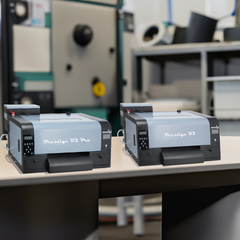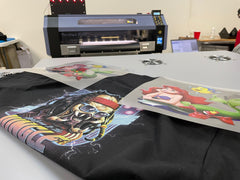What is Screen Print Emulsion?
Emulsion, or sometimes known as stencil systems, define the design. Screen printing emulsion is a light-sensitive liquid substance that creates an ink-resistant border around your image. Since all liquid emulsion and emulsion sheets (capillary film) are light-sensitive, application should be done in a darkroom or under ultra-violet (U.V.) safe lights. Before application, it is ideal to prep your screen by abrading and degreasing your screen. By preparing the mesh on aluminum or wooden frames, the emulsion is better able to adhere to the thin strands of mesh.
How to Choose the Right Emulsion?
Finding the best stencil system to use is something of a moving target. From diehards who commit to using the same materials for 35 years, to new printers whose knowledge is limited to an I-use-the-pink-emulsion approach, practitioners tend to stick with what they know. With modern stencil chemistry improvements over the last 10 years, it is often confusing which coating to use. There are many different types of emulsion to choose from depending on factors like your type of printing (manual versus automatic), job run (short versus long), ink type (plastisol versus water-based/discharge) and light source (fluorescent tubes versus LED versus metal-halide).
Emulsion comes in many different colors, with popular options being blue, green, red and clear. The color choice is a preference. One color is not better than another. Most screen printers pick a color of emulsion based on how easy it is to see through the screen to make registering jobs on-press easier.
Use the below screen printing emulsion guide to choose the best emulsion for you:
Capillary Film - Known as direct film or emulsion sheets, it has a precise thickness that offers good resolution and definition. Capillary Film is durable for long print runs. A great option for anyone not wanting to coat a screen with liquid emulsion. This film is considered one of the easiest ways to coat a frame. There is less mess and hassle that is involved comparerd to liquid emulsions. Plus, the capillary film creates an even and consistent emulsion over mesh (EOM) to minimize pinholes and stencil breakdown during long print runs. Although it will never be as durable as an appropriately applied stencil of direct emulsion, capillary film offers many other advantages; such as precise stencil thickness, reliable consistency, faster processing, and a significantly flattened learning curve.
Photopolymer Emulsion - Photopolymer liquid emulsions are premixed emulsions, ready to use out of the bucket. Pre-sensitized emulsion that exposes fast with a smaller exposure latitude. Can create thick E.O.M. (emulsion over mesh) for thick stencils. This makes it the best liquid emulsion for screen printers doing fine lines, half-tones, CMYK and simulated process printing. It is recommended to use a photopolymer emulsion with an LED exposure unit that has a vacuum top. Due to the fast stencil exposure, it is important to use an Kiwo exposure calculator to get the correct exposure time. Also, note that this type of screen printing stencil system can freeze easily, so stock up and store properly for colder weather.
Dual-Cure Emulsion - Dual-Cure liquid screen printing emulsions are one of the best emulsion choices for all types of screen printing. It uses a sensitizer to give better stencil strength and imaging. It is popular for experienced and beginner t-shirt printers due to their wide exposure latitude. It has high solid contents, wide exposure latitude and high resolution. Good for screen printers with LED and fluorescent tube exposure units. On average, dual-cure emulsions have a 35 - 45% solid content. The high solids contribute to faster drying, a sharp stencil and better emulsion over mesh (EOM) ratios. Also, note that this type of screen printing stencil system can freeze easily, so stock up and store properly for colder weather.
Water Resistant Emulsion - For screen printers using water-based screen printing ink or discharge ink, a water-resistant emulsion is necessary. Some of our Photopolymer Emulsions are also water resistant if you want one emulsion for plastisol and water-based screen printing inks.
Diazo Emulsion - a good emulsion choice for most screen printing applications. Can be used with solvent based inks, is abrasion resistant and reclaims easily. Screen printers like diazo emulsions because it is generally less expensive than other emulsion options. However, the less expensive aspect means it has a lower solids to liquid ratio compared to other emulsions like Dual-Cure and Photopolymer emulsions.
All screen printers need emulsion; it's the secret to the perfect exposure and printing success. Regardless of the type of screen printing you specialize in, or the type of screen exposure unit you use, Lawson has the right direct emulsion for you. We sell all the different types of screen printing emulsions available.




